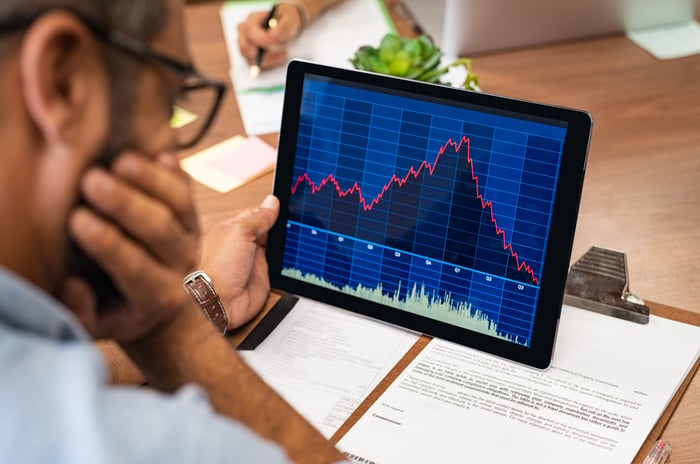Following a historically strong bounce from the March 2020 pandemic lows, Wall Street and investors have endured a rough start to 2022. Through this past weekend, the benchmark S&P 500 (^GSPC -0.35%) and technology-driven Nasdaq Composite were lower by 8.8% and 13.4%, respectively, on a year-to-date basis.
While double-digit percentage corrections of around 10% are fairly common for the broader market -- the S&P 500 has navigated its way through 39 double-digit percentage declines since the beginning of 1950 -- drops that exceed 20% aren't nearly as frequent.
Based on a number of potential headwinds, my suspicion is the broader market will head considerably lower in the coming weeks and/or months, and eventually make a run at bear market territory (a drop of at least 20%). Yet, in spite of this heightened volatility, I'm not too concerned.

Image source: Getty Images.
Five reasons the stock market could crash in the short term
Though there is a laundry list of catalysts that can push the S&P 500 and growth-oriented Nasdaq Composite lower, five stand out as most worrisome.
1. The Fed is pumping the brakes
The first issue is the Federal Reserve's plans to end quantitative easing (QE) measures and begin raising interest rates.
This, in itself, isn't an issue. In fact, I'd argue it's long overdue. The problem is that, in hindsight, the Fed likely overstimulated the economy with QE measures and has waited too long to take its foot off the gas. The end result is a 7.5% increase in the year-over-year inflation rate for January -- its highest year-over-year increase in 40 years.
The nation's central bank is going to have an extremely difficult time raising interest rates and reducing a balance sheet that holds trillions of dollars in U.S. Treasuries without tipping the U.S. back into recession. Wall Street knows this, which is why we're seeing so much angst about this upcoming monetary tightening cycle.

Image source: Getty Images.
2. We're in uncharted territory with inflation
Perhaps the one thing Wall Street and investors value above all else is certainty. Even though history doesn't repeat, it often rhymes. When it comes to inflation and the Fed, we're entering uncharted territory.
For instance, half the country wasn't even alive the last time the prices for goods and services were rising at such a precipitous pace. This means quite a few money managers, and a slew of retail investors, are getting a crash course in what it's like to invest in a high-inflation environment.
What's more, this'll be the first time the Fed kick-starts a monetary tightening cycle with all of the major indexes (S&P 500, Nasdaq Composite, and Dow Jones Industrial Average) below their respective 200-day moving averages. In other words, equities are as weak as they've ever been prior to the Fed taking its foot off the accelerator.

Image source: Getty Images.
3. History provides precedence for a pullback
History suggests the stock market is in trouble, too.
As an example, the Shiller price-to-earnings (P/E) ratio for the S&P 500 closed last week at 35.59, which is well over double its 151-year average of 16.92. But what's far more worrisome is how the S&P 500 has responded the previous times the Shiller P/E pushed above 30. In the four other instances where the S&P 500's Shiller P/E surpassed 30 during a bull market, the benchmark index went on to lose between 20% and 89% of its value after hitting its respective peak.
Before you get too concerned, understand that the 89% decline occurred during the Great Depression. It's extremely unlikely that such a financial meltdown would occur today. Nevertheless, a 20% decline has been the baseline expectation for the S&P 500 when valuations get extended, like they are now.

Image source: Getty Images.
4. Margin debt is at a precarious level
A fourth reason the stock market can plunge is due to the amount of outstanding margin debt. Margin debt is the money investors borrow with interest to purchase or short-sell securities.
According to data from the Financial Industry Regulatory Authority (better known as FINRA), outstanding margin debt in January was just shy of $830 billion. That's up 73% from March 2020, although it's down from a peak of $935.9 billion in October 2021.
While it's normal for margin debt to increase nominally over time, it's quite abnormal for margin debt to increase by 60% or more in a single year, as happened in 2021. In the two previous instances where margin debt jumped at least 60% in a year since 1995 (just prior to the dot-com bubble bursting and months before the financial crisis), the stock market cratered not long after. One bad day on Wall Street is all it takes sometimes for margin calls, and the escalated selling of equities tied to those calls, to hit.

Image source: Getty Images.
5. High-risk trades appear to be unwinding
Lastly, a number of high-risk trades that have brought retail dollars into the stock market are beginning to break down.
For example, the popular meme stock trade, which encouraged retail investors to pile into heavily short-sold stocks to effect a short squeeze, has quickly stalled out. As of Feb. 16, there were 86 stocks with a market cap of at least $300 million and short interest of at least 20%, relative to outstanding float. In total, 94% of these short squeeze stocks were lower over the trailing 90-day period, with 92% underperforming the S&P 500.
It's been a similar story with cryptocurrencies. In the blink of an eye, the aggregate value of digital currencies declined by more than $600 billion (about 30%) in a three-day stretch in January. If the crypto profit train slows or derails, money for equity investments could quickly dry up.

Image source: Getty Images.
Here's why I'm not worried (and you shouldn't be, either)
I freely admit that the above five reasons paints a bleak picture for the stock market. But it's not all bad news.
Even though the S&P 500 has undergone 39 corrections of at least 10% since the beginning of 1950, each and every one of these declines (save for the one that's ongoing) has eventually been erased by a bull market rally. Put another way, every crash and correction has represented an opportunity for patient investors to buy great companies at a discount. As long as you're looking years out, and not days or weeks, crashes and corrections can be quite exciting from the perspective of snagging bargains.
Another reason to put worry aside is the history behind stock market corrections. Of the 38 previous corrections in the S&P 500 dating back to the beginning of 1950 (i.e., not including the current correction), 24 of them found their bottom within 104 calendar days (about 3 1/2 months). Seven more hit bottom between 157 and 288 calendar days (roughly between five and 10 months). That's 82% of all corrections over the previous 72 years running their course in 10 months, or less. In other words, corrections may be unnerving at times, but they usually resolve quickly.
No matter what the stock market has in store over the coming weeks and months, there's no need to be concerned if you have time as your ally.




